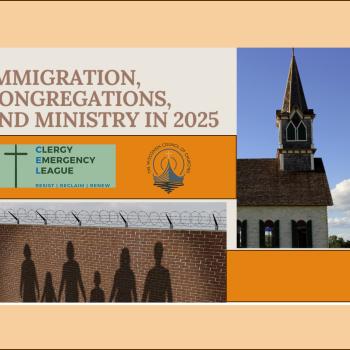Q & A with Bruce Epperly
1. How do you define the word mystic?
While there are many classical definitions of mysticism, I begin with the belief that God is intimately present in our lives. Mysticism is this-worldly, embodied, and incarnational. We don’t need to go anywhere, take a special training, make a vow of celibacy, or abandon our normal activities to have mystical experiences. I’m inspired by the “un-mystical” biblical character Jacob, a shrewd entrepreneur concerned primarily with the art of the deal, who goes to sleep under the stars and then has a dream of a ladder of angels and awakens, exclaiming, “God was in this place and I did not know it.”
A mystic affirms that “God is in this place, and I do know it.” If Jacob can become a mystic, then anyone can!
The heavens declare the glory of God, and so do our cells and nervous systems. God is constantly inspiring us, and sometimes we notice – that’s when the mystical moment emerges. A mystic stops long enough, sometimes intentionally and other times simply awakened by grace, to recognize that God is here with us, whether in the carpool to school, signing in to your e-mail account, playing with a child, or volunteering at a soup kitchen.
There are many varieties of mysticism, some of which involve drawing away from everyday life. Most of us, however, enter the mystic pathway when we discover a living, loving presence in everyday life and experience the holiness and radical amazement of life itself. Then we may, with Thérèse of Lisieux, do ordinary things with great love or, with Mother Teresa of Calcutta, make a commitment to do something beautiful for God. Today we need mystics more than ever—people who see holiness everywhere and then bring it forth in our families, communities, and political arenas.
2. What can today’s Christians learn from mystics who lived centuries ago? How are their experiences relevant to us?
The classical mystic is often seen as otherworldly, unmarried, and little concerned with the world in which we live. In reality, most mystics began their journey just as we do – with a sense of God’s presence that inspires them to seek to live a whole and holy life. Some mystics enter monasteries, but others, like Mother Teresa and St. Francis, immerse themselves in the challenges of human and non-human suffering. Others, like Brother Lawrence, discover God amid doing dishes for our children or at the homeless shelter. Some find solace that prompts them to compassion, like Etty Hillesum, a young woman who died in a German concentration camp during World War II. Still others, like Howard Thurman, are inspired by their mystical experiences to find healing in a racist society and then work to overcome the boundaries of race and religion.
A Zen Buddhist saying goes, “Before enlightenment, I chopped wood and carried water. After enlightenment, I chopped wood and carried water.” The mystic experiences, in her or his imperfection, God in all things and all things in God, and invests everyday life with wonder, gratitude, beauty, and healing.
I began The Mystic in You with a focus on Francis of Assisi and concluded with Julian of Norwich to portray the relevance of mysticism today – our need to care for the Earth and all its creatures and respond to suffering wherever it is found. We also need to believe that all will be well, despite the challenges we face environmentally, socially, and politically today.
3.In the introduction you say that this book grew out of seminars you were leading in your church (“A Month with a Mystic”). How did the people of your congregation respond to spending that much time with different mystics?
I think the initial response was “Me, a mystic? You have to be kidding!” But then it dawned on congregants and guests (this series brought scores of people from the community to our church) that mysticism can be lived on a day-to day-basis. They came to see that all the great religions began with encounters with God or the Holy and that many of the mystics we’ve studied –so far, we’ve studied about 30 – began right where they are today, as everyday people touched by God. This series, along with our congregation’s focus on spiritual and healing practices, has made prayer and silence commonplace and part of our decision-making processes at church.
You can be a mystic right where you are, paying bills, dealing with the aging process, calling your representative or protesting a governmental policy, or staying up with a sick child or life partner.
4.In addition to Christian mystics, your book includes Jewish mystics (Etty Hillesum and the Baal Shem Tov) and a well-known Sufi mystic (Rumi). Why did you choose to do this?
I believe that healthy spirituality is global. We are bound together, as Martin Luther King Jr. asserts, in a fabric of relatedness. We turn on the news and we are transported to Syria, Paris, Puerto Rico, Pakistan, or Korea. Our health care provider is a Sikh, Hindu, or Muslim, and we admire people like the Dalai Lama and Mahatma Gandhi. I wanted persons who came to our congregation’s series and the readers of this book to discover that wherever truth and healing are found, God is the source.
I also wanted to honor my own spiritual journey. After leaving the church as a teen, I rediscovered Christianity by learning transcendental meditation as a first-year college student. That experience brought me back to the church and inspired a thirst for deeper spiritual experiences. Like many, I didn’t identify spirituality with Christianity. There were no meditation classes or silent retreats in the churches of my youth. I wanted to investigate the Christian tradition of spiritual formation, and I have been doing this now for over 40 years as a pastor and teacher. I believe that we can learn from people of other spiritual traditions and discover that God’s truth, and the presence of Christ, can be found anywhere and in any religious community.
5.What are the main takeaways you hope people will get from reading this book?
I think the title says it all: The Mystic in You. Yes, the mystic in you! God is in the place where you are. As the Celts describe it, the world is filled with “thin places,” translucent to God’s presence. Moreover, I wanted to convey the interplay of mystical experience and compassion and, in many cases, social concern. Mysticism invites us to love more and see our common humanity, despite real differences in religion, culture, and politics. Many mystics went straight from the sanctuary to the streets to serve humankind and the world in all its brokenness and to see the face of God where it is often hidden.
I wanted the examples and practices of other mystics to inspire people to find spiritual practices that work for them in the complexities of their own lives. There are nearly 50 practices in this book, each of which has been spiritually “road tested” by me and taught in my congregation and the community. A variety of practices enables us discover the practices that best fit our personality type, spiritual experience, theological perspective, and lifestyle.
You don’t have to abandon the world to experience God. The world is our parish, as John Wesley asserts; it is also our spiritual classroom and the place where God meets us. By devoting our daily lives to awakening to God’s presence, we can be both heavenly minded and earthly good.
6. Who comes to mind when you think of present-day mystics?
Most of today’s mystics don’t like to admit it. They don’t want to separate themselves from everyone else. They recognize their fallibility and mortality but nevertheless let God’s light shine through. Still, there are people that I look to for spiritual counsel and models of everyday holiness. I have been influenced by “living mystics” such as the Vietnamese Buddhist monk Thich Nhat Hanh, the Tibetan spiritual teacher the Dalai Lama, and the ecological and justice spirituality of Pope Francis. I am also inspired by 20th-century mystics, now deceased, whom I have met or whose work has shaped my life such as Howard Thurman, Gerald May, Evelyn Underhill, Rabbi Abraham Joshua Heschel, and Madeleine L’Engle. Contemporary mystics – and they might not want to claim the title – who inspire me are the Celtic spiritual guide John Philip Newell, Tilden Edwards, Richard Rohr, Brian McLaren, Agnes Sanford, Morton Kelsey, Jay McDaniel, Annie Dillard, Mary Oliver, and Patricia Adams Farmer. There are many others, as there are mystics and saints everywhere!
Then again, the greatest inspiration comes from everyday people who find God in unexpected and difficult places and then share the light of God with others. Perhaps, the most inspiring model of messy-earthy mysticism I have experienced is an elderly African American man I regularly chatted with at a nursing home in Washington, DC, who took two bus transfers across town every day to sit and gaze lovingly at and serve gracefully his wife, who no longer knew who he was. I don’t even remember his name, and he’s probably long passed, but in that room, I could feel “God was in this place and I know it.” Mysticism is about a love that never ends – God’s love for us and our sharing in that love with others.
1. How do you define the word mystic?
While there are many classical definitions of mysticism, I begin with the belief that God is intimately present in our lives. Mysticism is this-worldly, embodied, and incarnational. We don’t need to go anywhere, take a special training, make a vow of celibacy, or abandon our normal activities to have mystical experiences. I’m inspired by the “un-mystical” biblical character Jacob, a shrewd entrepreneur concerned primarily with the art of the deal, who goes to sleep under the stars and then has a dream of a ladder of angels and awakens, exclaiming, “God was in this place and I did not know it.”
A mystic affirms that “God is in this place, and I do know it.” If Jacob can become a mystic, then anyone can!
The heavens declare the glory of God, and so do our cells and nervous systems. God is constantly inspiring us, and sometimes we notice – that’s when the mystical moment emerges. A mystic stops long enough, sometimes intentionally and other times simply awakened by grace, to recognize that God is here with us, whether in the carpool to school, signing in to your e-mail account, playing with a child, or volunteering at a soup kitchen.
There are many varieties of mysticism, some of which involve drawing away from everyday life. Most of us, however, enter the mystic pathway when we discover a living, loving presence in everyday life and experience the holiness and radical amazement of life itself. Then we may, with Thérèse of Lisieux, do ordinary things with great love or, with Mother Teresa of Calcutta, make a commitment to do something beautiful for God. Today we need mystics more than ever—people who see holiness everywhere and then bring it forth in our families, communities, and political arenas.
2. What can today’s Christians learn from mystics who lived centuries ago? How are their experiences relevant to us?
The classical mystic is often seen as otherworldly, unmarried, and little concerned with the world in which we live. In reality, most mystics began their journey just as we do – with a sense of God’s presence that inspires them to seek to live a whole and holy life. Some mystics enter monasteries, but others, like Mother Teresa and St. Francis, immerse themselves in the challenges of human and non-human suffering. Others, like Brother Lawrence, discover God amid doing dishes for our children or at the homeless shelter. Some find solace that prompts them to compassion, like Etty Hillesum, a young woman who died in a German concentration camp during World War II. Still others, like Howard Thurman, are inspired by their mystical experiences to find healing in a racist society and then work to overcome the boundaries of race and religion.
A Zen Buddhist saying goes, “Before enlightenment, I chopped wood and carried water. After enlightenment, I chopped wood and carried water.” The mystic experiences, in her or his imperfection, God in all things and all things in God, and invests everyday life with wonder, gratitude, beauty, and healing.
I began The Mystic in You with a focus on Francis of Assisi and concluded with Julian of Norwich to portray the relevance of mysticism today – our need to care for the Earth and all its creatures and respond to suffering wherever it is found. We also need to believe that all will be well, despite the challenges we face environmentally, socially, and politically today.
3.In the introduction you say that this book grew out of seminars you were leading in your church (“A Month with a Mystic”). How did the people of your congregation respond to spending that much time with different mystics?
I think the initial response was “Me, a mystic? You have to be kidding!” But then it dawned on congregants and guests (this series brought scores of people from the community to our church) that mysticism can be lived on a day-to day-basis. They came to see that all the great religions began with encounters with God or the Holy and that many of the mystics we’ve studied –so far, we’ve studied about 30 – began right where they are today, as everyday people touched by God. This series, along with our congregation’s focus on spiritual and healing practices, has made prayer and silence commonplace and part of our decision-making processes at church.
You can be a mystic right where you are, paying bills, dealing with the aging process, calling your representative or protesting a governmental policy, or staying up with a sick child or life partner.
4.In addition to Christian mystics, your book includes Jewish mystics (Etty Hillesum and the Baal Shem Tov) and a well-known Sufi mystic (Rumi). Why did you choose to do this?
I believe that healthy spirituality is global. We are bound together, as Martin Luther King Jr. asserts, in a fabric of relatedness. We turn on the news and we are transported to Syria, Paris, Puerto Rico, Pakistan, or Korea. Our health care provider is a Sikh, Hindu, or Muslim, and we admire people like the Dalai Lama and Mahatma Gandhi. I wanted persons who came to our congregation’s series and the readers of this book to discover that wherever truth and healing are found, God is the source.
I also wanted to honor my own spiritual journey. After leaving the church as a teen, I rediscovered Christianity by learning transcendental meditation as a first-year college student. That experience brought me back to the church and inspired a thirst for deeper spiritual experiences. Like many, I didn’t identify spirituality with Christianity. There were no meditation classes or silent retreats in the churches of my youth. I wanted to investigate the Christian tradition of spiritual formation, and I have been doing this now for over 40 years as a pastor and teacher. I believe that we can learn from people of other spiritual traditions and discover that God’s truth, and the presence of Christ, can be found anywhere and in any religious community.
5.What are the main takeaways you hope people will get from reading this book?
I think the title says it all: The Mystic in You. Yes, the mystic in you! God is in the place where you are. As the Celts describe it, the world is filled with “thin places,” translucent to God’s presence. Moreover, I wanted to convey the interplay of mystical experience and compassion and, in many cases, social concern. Mysticism invites us to love more and see our common humanity, despite real differences in religion, culture, and politics. Many mystics went straight from the sanctuary to the streets to serve humankind and the world in all its brokenness and to see the face of God where it is often hidden.
I wanted the examples and practices of other mystics to inspire people to find spiritual practices that work for them in the complexities of their own lives. There are nearly 50 practices in this book, each of which has been spiritually “road tested” by me and taught in my congregation and the community. A variety of practices enables us discover the practices that best fit our personality type, spiritual experience, theological perspective, and lifestyle.
You don’t have to abandon the world to experience God. The world is our parish, as John Wesley asserts; it is also our spiritual classroom and the place where God meets us. By devoting our daily lives to awakening to God’s presence, we can be both heavenly minded and earthly good.
6. Who comes to mind when you think of present-day mystics?
Most of today’s mystics don’t like to admit it. They don’t want to separate themselves from everyone else. They recognize their fallibility and mortality but nevertheless let God’s light shine through. Still, there are people that I look to for spiritual counsel and models of everyday holiness. I have been influenced by “living mystics” such as the Vietnamese Buddhist monk Thich Nhat Hanh, the Tibetan spiritual teacher the Dalai Lama, and the ecological and justice spirituality of Pope Francis. I am also inspired by 20th-century mystics, now deceased, whom I have met or whose work has shaped my life such as Howard Thurman, Gerald May, Evelyn Underhill, Rabbi Abraham Joshua Heschel, and Madeleine L’Engle. Contemporary mystics – and they might not want to claim the title – who inspire me are the Celtic spiritual guide John Philip Newell, Tilden Edwards, Richard Rohr, Brian McLaren, Agnes Sanford, Morton Kelsey, Jay McDaniel, Annie Dillard, Mary Oliver, and Patricia Adams Farmer. There are many others, as there are mystics and saints everywhere!
Then again, the greatest inspiration comes from everyday people who find God in unexpected and difficult places and then share the light of God with others. Perhaps, the most inspiring model of messy-earthy mysticism I have experienced is an elderly African American man I regularly chatted with at a nursing home in Washington, DC, who took two bus transfers across town every day to sit and gaze lovingly at and serve gracefully his wife, who no longer knew who he was. I don’t even remember his name, and he’s probably long passed, but in that room, I could feel “God was in this place and I know it.” Mysticism is about a love that never ends – God’s love for us and our sharing in that love with others.
1/19/2018 3:09:00 PM




